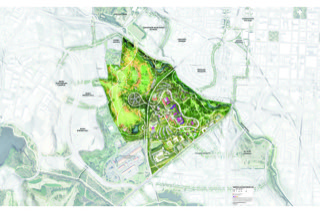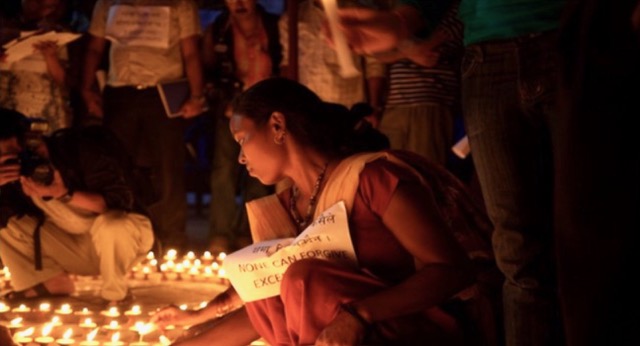Welcome to Every Path Speaks
Come walk with us.
Navigate this page by using the menu above or by scrolling through the page.
Simon Griffiths Photography
This video portrays the history of the site now occupied by Dorothea Dix Park and shares the stories of individuals linked together by their lives on this land. The paths crossing this 308-acre urban park hold the stories of individuals across thousands of years representing nomadic indigenous tribes, the plantation era, and a mental health hospital. As the city continues to develop the park site, it is their goal to honor and remember these legacies by gathering their descendants' and their representatives' oral histories.
About the Dix Park Oral History Project
How do you honor the long history of a site and its people while planning for the future? How do you balance the conflicting actions of historical figures and honor those injured? How do you promote well-being for the community through a park? These and other questions are integral to Dorothea Dix Park, under development in Raleigh, North Carolina.
The Dix Oral History project together with the park’s membership in the International Coalition of Sites of Conscience are initiatives designed to answer these questions, preserve the oral histories of the legacies associated with the Park, as well as to learn from them in order to shape a place where the well-being of the community is fostered, thus realizing “Memory to Action”.
Elizabeth Page, Volunteer Chair of the Dix Oral History project reflects, “But if we preserve the legacy of the land and all it's meant throughout many eras, that will make the park a richer place. And that way I feel like the legacy of Dix Hospital, Spring Hill Plantation and the Indigenous people before will live on much longer that way.”
The site holds the histories of Indigenous people beginning thousands of years ago, two hundred years as a plantation, and for 160 years as a state psychiatric hospital. Among these legacy groups, there are diverse themes to understand from the deleterious impact of colonization on Indigenous people, the enslavement of others, the development of a city and region, and the beneficial, but sometimes harmful mental health care practices.
The project has its origins in interviews conducted with former patients and staff of the hospital in 2016 by “North Carolina Health News.” The project, “Lives on the Hill” is the foundation for what is being built now. Community volunteers have identified hundreds of potential narrators representing the multi-faceted lives associated with the hospital era. Identification of representatives and descendants of the Indigenous and Plantation eras is also underway. The project is expected to be launched in early summer 2021.

Simon Griffiths Photography
Narrators

Danny Bell
"No one really tells the story of Indians in the South. The people or settlers settling this land did not want the Indian problem. American Indians did get some identity, but for the most part, we were written out of the record. So it's important for us to capture as much as we can about who we were and where we were. There are stories here that are in the landscape that we have not fully thought through and if we walk the land, the land may communicate to us in ways we may not understand."
Belle Long
"It's affirmed for me the things that he said, affirmed for me, the work that I've been doing on equity and inclusion for the last year, and my sense that the world is really an unjust place for Black people. I admire them so much because they have overcome obstacle after obstacle that white people have thrown down in front of them and trying to hold them back - and it just it breaks my heart to learn more about it as I go through all of this and and know that people that were my ancestors were involved in this."

Belle Long is President of the Wake County Historical Society and former Executive Director of the Joel Lane Museum House, whose mission is, “To bring American history to life by providing a rich understanding of regional North Carolina history and the struggles, sacrifices, and achievements of those who lived in Piedmont North Carolina in the 18th century, with particular emphasis on the life and times of Colonel Joel Lane, his family, and enslaved workers.”
Belle is an avid, admittedly amateur, but passionate genealogist. Her research led her to discover her ancestor, Theophilus Hunter Sr., one of the founders of the City of Raleigh and owner of the Spring Hill Plantation. As a result of this research, she was also instrumental in helping to prevent the removal of seventeen ancestor graves from the former plantation site. Belle is a member of the Dix Park Sites of Conscience Work Group.

Demetrius Hunter
"It just seemed like there was a spiritual awakening for me to understand that my ancestors are crying out for me to know that they were a part of that land. It was also a time for me to know that it's time for reckoning, and it’s time for reparations. Reparations for the Blacks that have endured such hardship, and were enslaved in that type of capacity. It is a very difficult situation to be in the space, walking on the land. I've walked it many times thereafter the visit that we had and to know that moving forward the reckoning should take place. There should be in this new future generation of this park, some memorializing, some legacy, some reparations. There should always be a memory and there should always be a landmark, and there should also be some reparations in this planning. I don't see that it would be equity until that takes place.
For so many years and generations, we have not, as a people, been able to tell our stories. As Hunter family members, we want to share our story. Because a lot of our history is lost and the only, the only way, and the best way is to be able to own your story."
Demetrius Hunter is the owner of the Black-Market Farmer’s Hub, an outlet for Black and Brown Farmers' produce as well as a specialty food store for the local community. Hunter is also the Founder of the non-profit Grocers on Wheels which delivers fresh produce to the community, particularly those areas identified as food deserts in Southeast Raleigh, and is in partnership with numerous non-profits in the community to assist with food distribution efforts to residents in need.
A self-taught genealogist, he has researched his family’s ancestry for approximately two decades. During his search, he discovered that he was descended from an individual who was enslaved at Spring Hill Plantation. Demetrius is a member of the Dix Park Sites of Conscience Work Group.
Richard Young MD
"But I think if any way we keep society conscious of what it's like to be mentally ill and what it's like to have to get treated and have people telling you what to do and people giving you medicine and trying to talk you into it when you don't even know it's good for you. You know, things like that are very important
I think that the land is a little bit sacred in certain ways. And you can preserve that sacredness through history by keeping it a park versus just having another set of buildings going there."

Dr. Richard Young is a psychiatrist retired from a medical practice that parallels that of his father Dr. David Young, who was North Carolina's first General Superintendent of the mental-health system as well as Acting Superintendent at Dix for two years. Dr. Dick Young was a medical director of a hospital, opening five psychiatric units and closing two during his long career. The superintendent’s house on the Dorothea Dix Hospital campus was later named in honor of his father for his many contributions to the care of Dix patients and innovative programs that improved the care of the mentally ill such as his development of a resident training program and implementation of an anti-alcoholism program.

Wannetta Worthy
"I have a feeling, and I believe that the Universe through the spirit of John Hunter is bringing all of us together, and he is revealing, and he is establishing connections that, I believe, are going to lead to the unveiling of a story that is so much greater than what it is that we know. I think the Ancestors are calling us, including the City of Raleigh and its public institutions, to unwrap this gift."
Wannetta is a retired bank compliance officer who lives in Harlem, New York. Her mother is a direct descendant of the African American builder and North Carolina political leader Stewart Ellison. Following his first wife, Mary Davis's, death, Ellison married Narcissa Lucas, granddaughter of John Hunter, who was enslaved at Spring Hill. Hunter lived with Stewart and Narcissa following emancipation and helped raise Stewart's three daughters from his first marriage. Wannetta’s family members are the children of Ellison’s daughter Sophia and her husband John W Lee. Wannetta describes how she also views John Hunter as family, “How often have we found ourselves being cared for, guided, supported unconditionally by somebody 'not blood-related,' more so than from a parent or relative?”
Upon learning of her ancestor's connection to Spring Hill, Wannetta and family members came to Raleigh in November 2019 at the invitation of the City of Raleigh Museum Director, Ernest Dollar, to learn more about her family's recently discovered history. That visit is chronicled here. Wannetta is a member of the Dix Park Sites of Conscience Work Group.
About Dorothea Dix Park
Dorothea Dix Park has a layered and complex history. Before it was a park it was an indigenous hunting ground, a plantation and then North Carolina’s first mental health hospital.
Following the hospital’s closure the city of Raleigh purchased the 308 acre campus from the state and embarked on a plan to transform the site into an urban destination park. The effort to create Dorothea Dix Park is a public-private partnership between the City, which owns and operates the park, and the Dorothea Dix Park Conservancy acting as its philanthropic partner.

The site blends historic architecture and rich landscapes into a unique destination in the heart of Raleigh, North Carolina. This public space will feature play areas for all ages and interests, places for reflection, celebration, and mental well-being as well as commemorative spaces honoring the land’s history and those whose lives are intertwined with it.
The Master Plan details the approach to converting the site’s six distinct landscapes (creek, meadow, grove, gateway, ridge and valley) with full build-out likely requiring decades to execute.
There are three key principles that are guiding each aspect of the transformation of the park:
- Open Up and Connect by focusing on community access to inclusion
- Build From What Is There by respecting and building on the past
- Offer Something for Everyone by offering a range of activities and celebrating diversity

The principle of Building from “What is There” highlights the role of oral history can play in the park’s development. As acknowledged in the Master Plan, “The qualities and character of a great park grow out of the specifics of its site and context. Accordingly, the events and remnants of natural and human history found on the Dix Park site are not challenges to overcome or to erase. Rather, the site’s past includes important resources—the physical materials, stories, and experiences—to make and shape the future park.”
Two projects currently underway include the renovation of the non-denominational All Faith’s Chapel and the Plaza & Play area.
Over the years, the chapel held non-denominational services for the patients and staff of the Dix Hospital campus and was a place of peace and comfort for many who resided at Dix. The chapel also hosted weddings, funerals, retirement celebrations and other gatherings for those connected with the hospital.
Plaza & Play will be a public space for all ages with unique play spaces, a civic plaza, fountains, gardens, and areas to cookout. The history of the site will also incorporate public art, interpretive signage, and a restored historic house.

Simon Griffiths Photography
Dorothea Dix Hospital
Dorothea Dix Hospital, North Carolina’s first psychiatric hospital, was founded in 1856 and named after mental health advocate Dorothea Dix. The hospital was at the forefront of the mental health hospital movement in America. Marjorie O’Rourke in her book, Haven on the Hill, characterizes the movement as a time “Where patients would receive humane, compassionate care, education in the principles of healthful living, and the benefits of useful employment and appropriate entertainments.” During its 160-year existence, Dorothea Dix Hospital became such a place.
Below is a timeline of the hospital’s development and eventual closure in 2012. In 2015, the City of Raleigh and the State of North Carolina agreed to the purchase of the 308 - acre site by the city. A Master Plan was created to develop a “Park Built by Everyone for Everyone,” and to embody a renewed place of healing and well-being. The city is in the first phase of executing the Master Plan.
This timeline was created for Lives on the Hill, a project created by North Carolina Health News in 2016.
Simon Griffiths Photography


